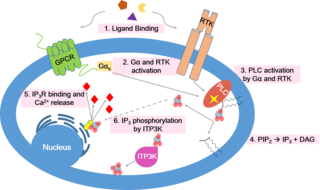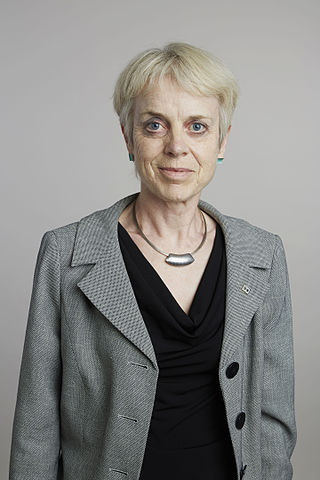Related Research Articles
Inositol trisphosphate or inositol 1,4,5-trisphosphate abbreviated InsP3 or Ins3P or IP3 is an inositol phosphate signaling molecule. It is made by hydrolysis of phosphatidylinositol 4,5-bisphosphate (PIP2), a phospholipid that is located in the plasma membrane, by phospholipase C (PLC). Together with diacylglycerol (DAG), IP3 is a second messenger molecule used in signal transduction in biological cells. While DAG stays inside the membrane, IP3 is soluble and diffuses through the cell, where it binds to its receptor, which is a calcium channel located in the endoplasmic reticulum. When IP3 binds its receptor, calcium is released into the cytosol, thereby activating various calcium regulated intracellular signals.

Calcium ions (Ca2+) contribute to the physiology and biochemistry of organisms' cells. They play an important role in signal transduction pathways, where they act as a second messenger, in neurotransmitter release from neurons, in contraction of all muscle cell types, and in fertilization. Many enzymes require calcium ions as a cofactor, including several of the coagulation factors. Extracellular calcium is also important for maintaining the potential difference across excitable cell membranes, as well as proper bone formation.
A hormone receptor is a receptor molecule that binds to a specific hormone. Hormone receptors are a wide family of proteins made up of receptors for thyroid and steroid hormones, retinoids and Vitamin D, and a variety of other receptors for various ligands, such as fatty acids and prostaglandins. Hormone receptors are of mainly two classes. Receptors for peptide hormones tend to be cell surface receptors built into the plasma membrane of cells and are thus referred to as trans membrane receptors. An example of this is Actrapid. Receptors for steroid hormones are usually found within the protoplasm and are referred to as intracellular or nuclear receptors, such as testosterone. Upon hormone binding, the receptor can initiate multiple signaling pathways, which ultimately leads to changes in the behavior of the target cells.

The cardiac action potential is a brief change in voltage across the cell membrane of heart cells. This is caused by the movement of charged atoms between the inside and outside of the cell, through proteins called ion channels. The cardiac action potential differs from action potentials found in other types of electrically excitable cells, such as nerves. Action potentials also vary within the heart; this is due to the presence of different ion channels in different cells.
Calcium release-activated channels (CRAC) are specialized plasma membrane Ca2+ ion channels. When calcium ions (Ca2+) are depleted from the endoplasmic reticulum (a major store of Ca2+) of mammalian cells, the CRAC channel is activated to slowly replenish the level of calcium in the endoplasmic reticulum. The Ca2+ Release-activated Ca2+ (CRAC) Channel (CRAC-C) Family (TC# 1.A.52) is a member of the Cation Diffusion Facilitator (CDF) Superfamily. These proteins typically have between 4 and 6 transmembrane α-helical spanners (TMSs). The 4 TMS CRAC channels arose by loss of 2TMSs from 6TMS CDF carriers, an example of 'reverse' evolution'.

Calcium signaling is the use of calcium ions (Ca2+) to communicate and drive intracellular processes often as a step in signal transduction. Ca2+ is important for cellular signalling, for once it enters the cytosol of the cytoplasm it exerts allosteric regulatory effects on many enzymes and proteins. Ca2+ can act in signal transduction resulting from activation of ion channels or as a second messenger caused by indirect signal transduction pathways such as G protein-coupled receptors.
Sir Michael John Berridge (22 October 1938 - 13 February 2020) was a British physiologist and biochemist. He was known for his work on cell signaling, in particular the discovery that inositol trisphosphate acts as a second messenger, linking events at the plasma membrane with the release of calcium ions (Ca2+) within the cell.
Calcium-induced calcium release (CICR) describes a biological process whereby calcium is able to activate calcium release from intracellular Ca2+ stores (e.g., endoplasmic reticulum or sarcoplasmic reticulum). Although CICR was first proposed for skeletal muscle in the 1970s, it is now known that CICR is unlikely to be the primary mechanism for activating SR calcium release. Instead, CICR is thought to be crucial for excitation-contraction coupling in cardiac muscle. It is now obvious that CICR is a widely occurring cellular signaling process present even in many non-muscle cells, such as in the insulin-secreting pancreatic beta cells, epithelium, and many other cells. Since CICR is a positive-feedback system, it has been of great interest to elucidate the mechanism(s) responsible for its termination.

Ca2+ ATPase is a form of P-ATPase that transfers calcium after a muscle has contracted. The two kinds of calcium ATPase are:
A calcium spark is the microscopic release of calcium (Ca2+) from a store known as the sarcoplasmic reticulum (SR), located within muscle cells. This release occurs through an ion channel within the membrane of the SR, known as a ryanodine receptor (RyR), which opens upon activation. This process is important as it helps to maintain Ca2+ concentration within the cell. It also initiates muscle contraction in skeletal and cardiac muscles and muscle relaxation in smooth muscles. Ca2+ sparks are important in physiology as they show how Ca2+ can be used at a subcellular level, to signal both local changes, known as local control, as well as whole cell changes.
Coincidence detection is a neuronal process in which a neural circuit encodes information by detecting the occurrence of temporally close but spatially distributed input signals. Coincidence detectors influence neuronal information processing by reducing temporal jitter and spontaneous activity, allowing the creation of variable associations between separate neural events in memory. The study of coincidence detectors has been crucial in neuroscience with regards to understanding the formation of computational maps in the brain.
In the field of molecular biology, the cAMP-dependent pathway, also known as the adenylyl cyclase pathway, is a G protein-coupled receptor-triggered signaling cascade used in cell communication.
Calcium pumps are a family of ion transporters found in the cell membrane of all animal cells. They are responsible for the active transport of calcium out of the cell for the maintenance of the steep Ca2+ electrochemical gradient across the cell membrane. Calcium pumps play a crucial role in proper cell signalling by keeping the intracellular calcium concentration roughly 10,000 times lower than the extracellular concentration. Failure to do so is one cause of muscle cramps.

Anoctamin-1 (ANO1) also known as Transmembrane member 16A (TMEM16A) is a protein that, in humans, is encoded by the ANO1 gene. Anoctamin-1 is a voltage-gated calcium-activated anion channel, which acts as a chloride channel and a bicarbonate channel. additionally Anoctamin-1 is apical iodide channel. It is expressed in smooth muscle, epithelial cells, vomeronasal neurons, olfactory sustentacular cells, and is highly expressed in interstitial cells of Cajal (ICC) throughout the gastrointestinal tract.

Jonathan Felix Ashmore is a British physicist and Bernard Katz Professor of Biophysics at University College London.

Annette Catherine Dolphin is a Professor of Pharmacology in the Department of Neuroscience, Physiology and Pharmacology at University College London (UCL).

Antony Giuseppe Galione is a British pharmacologist. He is a professor and Wellcome Trust senior investigator in the Department of Pharmacology at the University of Oxford.

David Alfred Eisner, FRCP (Hon), FMedSci, is British Heart Foundation Professor of Cardiac Physiology at the University of Manchester and editor-in-chief of The Journal of General Physiology (JGP).
David G. Nicholls is Professor Emeritus of Mitochondrial Physiology at the Buck Institute for Research on Aging in Novato, California. His research focuses on chemiosmosis proposed by Peter D. Mitchell to couple the electron transport chain to ATP synthase. His explanation of chemiosmotic theory in the textbook Bioenergetics has become the standard text in the field. He was elected a Fellow of the Royal Society (FRS) in 2019 for "substantial contribution to the improvement of natural knowledge".

Alexei Verkhratsky, sometimes spelled Alexej, is a professor of neurophysiology at the University of Manchester best known for his research on the physiology and pathophysiology of neuroglia, calcium signalling, and brain ageing. He is an elected member and vice-president of Academia Europaea, of the German National Academy of Sciences Leopoldina, of the Real Academia Nacional de Farmacia (Spain), of the Slovenian Academy of Sciences and Arts, of Polish Academy of Sciences, and Dana Alliance for Brain Initiatives, among others. Since 2010, he is a Ikerbasque Research Professor and from 2012 he is deputy director of the Achucarro Basque Center for Neuroscience in Bilbao. He is a distinguished professor at Jinan University, China Medical University of Shenyang, and Chengdu University of Traditional Chinese Medicine and is an editor-in-chief of Cell Calcium, receiving editor for Cell Death and Disease, and Acta Physiologica and member of editorial board of many academic journals.
References
- 1 2 3 Stephenson, Barnabas (25 September 2019). "Man becomes first from Hull to be inducted into prestigious group". Hull Daily Mail . Archived from the original on 1 November 2019.
- 1 2 Parekh, Anant B. (1991). Stimulus-contraction coupling in circular smooth muscle of guinea-pig stomach (DPhil thesis). University of Oxford. OCLC 59947010. EThOS uk.bl.ethos.292570.
- 1 2 Anant Parekh publications from Europe PubMed Central
- 1 2 Anant Parekh publications indexed by the Scopus bibliographic database. (subscription required)
- 1 2 "Anant Parekh – Physiology, Anatomy and Genetics". Oxford: University of Oxford.
- ↑ "Professor Anant Parekh". Oxford: University of Oxford.
- 1 2 Anant Parekh's ORCID 0000-0002-4860-1644
- 1 2 3 Parekh, Anant B.; Putney, James W. (2005). "Store-Operated Calcium Channels". Physiological Reviews. 85 (2): 757–810. doi:10.1152/physrev.00057.2003. ISSN 0031-9333. PMID 15788710.
- 1 2 3 4 5 6 7 8 Anon (2019). "Professor Anant Parekh FRS". royalsociety.org. London: Royal Society. Archived from the original on 24 April 2019.
 Material was copied from this source, which is available under a Creative Commons Attribution 4.0 International License.
Material was copied from this source, which is available under a Creative Commons Attribution 4.0 International License. - ↑ Parekh, A. B.; Penner, R. (1997). "Store depletion and calcium influx". Physiological Reviews. 77 (4): 901–930. doi:10.1152/physrev.1997.77.4.901. ISSN 0031-9333. PMID 9354808.
- ↑ Parekh, Anant B.; Terlau, Heinrich; Stühmer, Walter (1993). "Depletion of InsP3 stores activates a Ca2+ and K+ current by means of a phosphatase and a diffusible messenger". Nature. 364 (6440): 814–818. Bibcode:1993Natur.364..814P. doi:10.1038/364814a0. ISSN 0028-0836. PMID 8395025. S2CID 4339790.
- ↑ Parekh, Anant B. (2016). "Advances in intracellular Ca2+signalling". The Journal of Physiology. 594 (11): 2811–2812. doi:10.1113/JP272230. ISSN 0022-3751. PMC 4887675 . PMID 27246547.
- ↑ Anon (2012). "Professor Anant Parekh". acmedsci.ac.uk. London: Academy of Medical Sciences.
- ↑ Anon (2003). "Parekh" . Who's Who (online Oxford University Press ed.). Oxford: A & C Black. doi:10.1093/ww/9780199540884.013.U30023.(Subscription or UK public library membership required.)